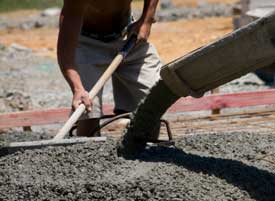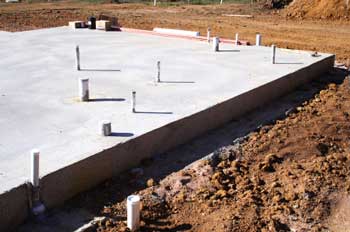Understanding the Influence of Vapor Retarders
Water is a crucial ingredient in a strong concrete mixture. Contractors know that, and consumers should. The imagination struggles, however, with the idea that concrete needs to breathe its moisture back into the atmosphere once poured. Concrete is not alive, yet the interactive, natural process of moisture evaporation is at the core of understanding the need for vapor retarders.
A moisture problem in a concrete slab can be externally caused. Once the slab is poured, excess moisture can permeate it from a variety of sources: ground moisture below the slab, high air humidity (even dramatic changes in relative humidity), and leaky plumbing to name a few. Any of these can create vapors that migrate into the concrete and raise its overall moisture levels. Excess moisture can alter pH levels in ways that adversely affect adhesives. At the very least, the concrete holds more water than it should. That destabilizes floors.
Moisture headaches can also originate within a concrete mixture. Adding too much water, whether on purpose (specification) or accident (adding excess water from mix truck), will extend the “drying” process. The moisture  within the concrete needs to naturally evaporate (known as “wicking”) by rising to the surface of concrete. If this process is not given the appropriate time and conditions, the concrete will not be appropriate to receive a moisture sensitive flooring product. In effect, the very element that makes concrete soluble, water, also creates flooring failures when not recognized and dealt with properly.
within the concrete needs to naturally evaporate (known as “wicking”) by rising to the surface of concrete. If this process is not given the appropriate time and conditions, the concrete will not be appropriate to receive a moisture sensitive flooring product. In effect, the very element that makes concrete soluble, water, also creates flooring failures when not recognized and dealt with properly.
Luckily, builders can install under slab vapor retarders. Put simply, the retarders enhance moisture wicking by blocking under slab moisture from interfering with the concretes naturals process of drying. Not only that, but vapor retarders can be critical in protecting flooring and adhesives. They can block certain harmful gases that may escape the building materials over time. A simple vapor retarder can prevent mold and mildew from growing due to excess floor moisture. Vapor retarders are typically applied over a layer of granular fill. Contractors place vapor retarders overfill so they can float the concrete sooner. Seams must properly seal heavy grade materials whose low permeance rates allow for traffic without moisture penetration. The American Society for Testing and Materials (ATSM) International details the installation and inspection of vapor retarders under concrete in sections ASTM E1745-09 and ASTM E1643.
Water vapor permeance, or “perms,” is the amount of allowable moisture migration within a concrete slab. The application of the concrete, as well as its mix, can determine permeability. For example, water vapor permeance is generally acceptable at less than 0.3 perms. However, a higher perm rate can be accepted in residential circumstances. Industry manufacturers specify vapor perms when producing their products, and builders must beware of the need to deploy materials whose moisture migration rates match each other. The vapor retarder underneath the slab must have a lower degree of permeance than the floor covering above it. Otherwise, the potential for a moisture-related flooring failure still exists. There are many ways to mitigate moisture in concrete.
All meaningful constructs require time, and successful concrete procurement is no different. The universal truth remains: concrete must dry before flooring or coatings are installed. Moisture must rise from the bottom of the slab to the top in order to evaporate.  If time is tight, builders can apply moisture remediation membranes which can assist in encapsulating the moisture in the slab so that flooring can be installed more quickly. In essence, you would be putting a moisture retarder on the top and bottom of the slab. Once the concrete is poured, the key is to resist installing a floor on a slab before it is adequately dry.
If time is tight, builders can apply moisture remediation membranes which can assist in encapsulating the moisture in the slab so that flooring can be installed more quickly. In essence, you would be putting a moisture retarder on the top and bottom of the slab. Once the concrete is poured, the key is to resist installing a floor on a slab before it is adequately dry.
Relative Humidity (RH%) monitoring can be the key to discovering the prime time to install flooring on concrete. RH sensors help determine the dryness of concrete, and that determines when installers can safely move forward. The accurate measure of moisture levels not only ensures strong flooring but strong adhesive bonds. High moisture levels and high PH levels typically run hand in hand and badly affect adhesives and installations.
The choice of a good vapor retarder lays the groundwork for successful flooring installation even before the concrete is poured. Select the best vapor retarder based on a thorough knowledge of local conditions, materials guidelines and careful application. Choose well, and a vapor retarder constitutes a strong and healthy concrete slab construction devoid of costly, failed flooring installation.